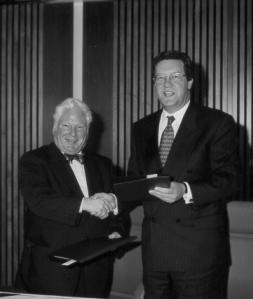Annual Report 1999-2000
Operation
of the national authority for implementation of the CTBT, including development
of CTBT verification and arrangements
in support of Australias CTBT commitments.
Milestone E1
E1.1 Operate
effectively as the national point of liaison with the CTBTO and other States in
relation to the fulfilment of Australias obligations under the CTBT.
In March 2000, Mr Downer signed an arrangement during the visit by Dr Hoffmann
E1.2 Facilitation
and enhancement of Australias technical contributions to the work of the
Preparatory Commission and its working groups.
Activities
ASNO commenced its
activities as Australias CTBT national authority in July 1998. As the Treaty and Australias implementing
legislation are not yet in force, and the Treaty has only provisional
application, ASNO does not carry out the full range of anticipated legal
functions. Practical work on
development of the CTBT's verification system ahead of entry into force is
however significant and advancing steadily.
ASNO has established and continues to develop contacts with the CTBTOs
Provisional Technical Secretariat (PTS) and with Australian governments,
agencies and institutions with a stake in CTBT activities, especially the
development of the International Monitoring System (IMS). Annex I lists Australian IMS stations.
To facilitate
the development of Australian IMS stations, ASNO concluded the negotiation
during the year of a Facility Arrangement with the CTBTO Preparatory
Commission. This Arrangement sets out
requirements and procedures governing the establishment, upgrade and operation
of IMS stations in Australia. The
estimated value of these activities is $25 million over the coming five years. The Facility Arrangement was signed by the
Minister for Foreign Affairs, Mr Downer, and the Executive Secretary of
the CTBTO Preparatory Commission, Dr Wolfgang Hoffmann, during
Dr Hoffmann's visit to Australia in March 2000.
Australian IMS stations
will be operated on behalf of the Government by organisations with specialist
expertise in CTBT verification, such as ARPANSA, the Australian Geological Survey Organisation
(AGSO) and the Australian National University (ANU).
The single
largest IMS project in Australia will be the establishment of a hydroacoustic
monitoring station off Cape Leeuwin in Western Australia (see page 76 of
this report for a background article on the station). ASNO worked closely during the year with the PTS, with Western
Australian government agencies, and with the consortium installing the station,
to facilitate agreement on work proceeding in 2000-2001.
ASNO took part
in technical working group sessions at the Preparatory Commission headquarters
in Vienna in September 1999 and February and May 2000, and works closely with
Australias technical specialists (from AGSO and
ARPANSA) who have contributed over many years to the negotiation and
development of the Treaty. ASNO's own
long experience in treaty verification is now contributing in particular to
work establishing procedures for the conduct of an On Site Inspection
(OSI). The role of an OSI is to
establish, through activities on the ground, whether an explosive nuclear test
has been carried out in violation of the CTBT.
Performance Assessment
ASNO has developed
effective liaison with stakeholders in the IMS development process, with useful
results during the year advancing preparation for entry into force of the CTBT.
Conclusion by ASNO of
Australia's IMS facility arrangement has been widely welcomed among
stakeholders, as have developments paving the way for establishment of new IMS
stations in Australia.
The signature of
Australia's Facility Arrangement, as well as the announcement of contracts for
installation of the hydroacoustic station off Cape Leeuwin, offered useful
opportunities for Mr Downer to underline Australia's ongoing commitment to
the CTBT.
Australia is widely
regarded as making a key contribution to the technical development of the CTBT
and its verification. ASNO has worked
successfully to co-ordinate Australia's input in this area during the year and,
drawing on its own areas of expertise, to make a substantial contribution.
Milestone E2
Timely establishment
and maintenance of legal and administrative mechanisms which will give effect
to CTBT obligations in Australia.
Activities
Although the Comprehensive Nuclear Test-Ban Treaty Act
1998 received Royal Assent on 2 July 1998, under
section 2 of the Act it will not come into force before the day the CTBT enters
into force, which will occur 180 days after the Treaty has been ratified by 44
named States. At 30 June 2000, 155
States had signed the treaty, of which 57 had deposited instruments of
ratification. These included 29 of the
named 44.
The CTBTO PTS manages
the development of the IMS internationally and funds the upgrade or
establishment of stations from the contributions of CTBT signatories. To facilitate this work, Australia signed a
Facility Arrangement with the CTBTO Preparatory Commission on 11 March 2000
(see also page 76). ASNO managed the preparation of regulations
establishing privileges and immunities required by this arrangement. The Preparatory Commission for the
Comprehensive Nuclear-Test-Ban Treaty Organization (Privileges and Immunities)
Regulations 2000 were gazetted on 1 June 2000.
Consistent with
principles set out in the CTBT, activities associated with the development of
its verification are funded primarily from the contributions of
signatories. This includes training of
people involved with the work of the Treaty.
ASNO coordinates the involvement of Australians in this training. During the year three Australians took part
in training for future responsibilities as station operators, or as inspectors
to be deployed should the Treatys On-site Inspection provisions be invoked.
Performance Assessment
With the conclusion of
Australia's Facility Arrangement and associated regulations, the legal basis
for IMS establishment activities in Australia prior to entry into force of the
CTBT has been advanced. A further step
for 2000-01 will be to put in place arrangements between the Australian
Government and technical agencies or institutions that will operate IMS
stations on Australia's behalf.
The training and
experience, gained both in Australia and overseas, that has accompanied
development and maintenance of the CTBTs verification mechanism has provided
ASNO with opportunities to nurture a base of expertise in nuclear monitoring
and verification issues.
Return to the ASNO Annual
Report Index | Output FNew Non-Proliferation Regimes

